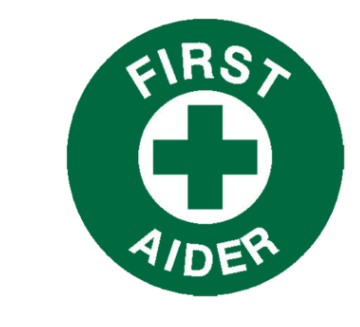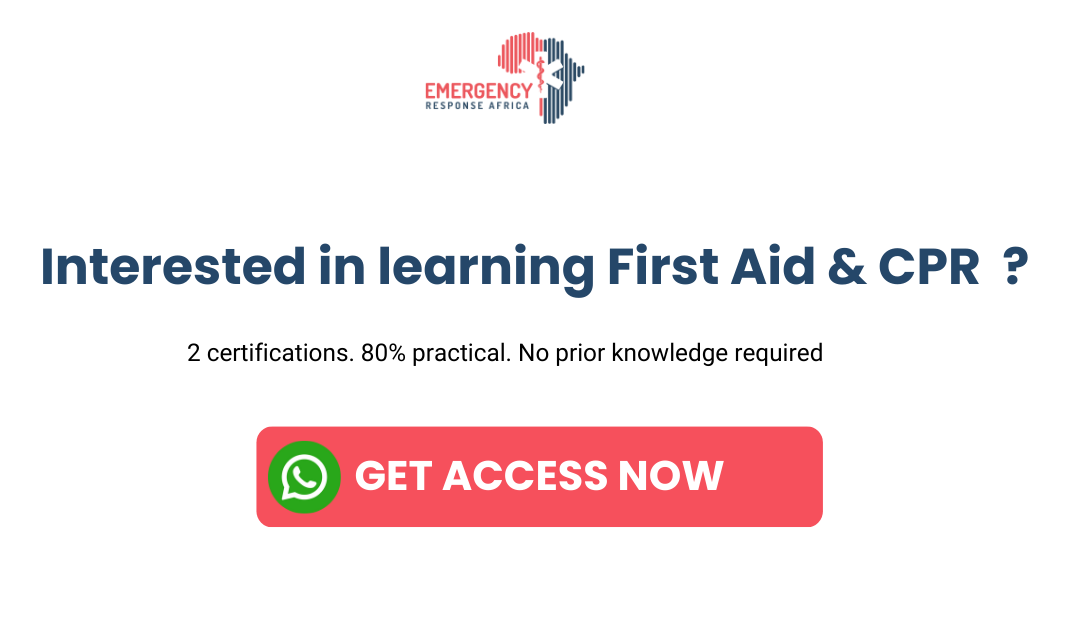Having a first aider present can save lives and provide immediate care in emergencies. Knowing who a first aider is and how to become one in 2024 is vital. Learn how to get started and be emergency prepared.
Who is a first aider, and how to become one in 2024
A first aider is a person who gives immediate help to someone ill or injured—at the same time, ensuring that the victim and those at the scene of accidents are safe, including themselves.
Sometimes, the injury can be minor or workplace injury. In the case of a workplace injury, the first aider among the employees can manage the situation until help comes from an emergency service like Emergency Response Africa (ERA).
The first aider is responsible for reassuring the casualty of getting through the accident while waiting for further help from the doctor, medical professional, or the hospital. A first aider could be a bystander, someone like you who recognizes an emergency and decides to help.
While it’s beneficial for everyone to have a basic understanding of first aid, it’s of more importance to realize that first aid is a skill everyone should learn and practice. At ERA, we emphasize that every office ensures its human capacity is motivated to take this life-saving skill seriously.
Characteristics of a Good First Aider
-
Good Communication Skills
The first aider should understand that the sick person is in a state of shock and pain, so communication with such a person can be a whole task. Hence, the first aider must have excellent communication skills and a natural ability to talk to people. This skill is vital, especially when the first aider is about to pass the patient to another level of care.
-
Teamwork
A good team player makes an excellent first aider; in the case of an organization, looking for someone with team spirit is important. The First aiders are often required to work alongside the emergency service unit team and, much more, the ambulance team.
-
Ability to Work Under Pressure
Cut in the finger to cardiac arrest. A first-aider must be calm under pressure and manage any situation because panicking can lead to more casualties.
-
Leadership
A first aider may have to take the lead in ensuring that during an emergency, nothing escalates by organizing bystanders to assist in various tasks, such as carrying out a spinal log roll and others.
-
Knowledge of Their Limits
The first aider should realize there is a limit to their skill and call for further help when and where necessary.
-
Empathetic
When injured or affected physically, they are bound to feel scared, anxious, and confused. The first aider’s role is to calm the situation with empathy, which puts the victim and everyone around at ease. Be empathetic with the casualty while you observe the severity of the situation.
-
Observant
First aiders need to be able to evaluate a situation and assess the related risks as soon as possible. They should be observant enough to mentally jot down the risks involved at that moment for both the patients and themselves. The ambience surrounding the victim could bring about fresh risks. A first aider is responsible for identifying these risks, after which they should determine the action to take immediately, even before approaching the casualty.
RELATED SERVICES:
-
Physically Fit
Emergencies can occur in different situations. Most times, the victim is not around the accident scene and will be required to get there on time. First aiders should be able to show that they are physically fit, get there on time, and take charge of the emergency before EMS arrives.
-
Confident
A competent first aider is confident in handling a situation and administering any assistance the case demands. Even if they don’t receive a response initially or immediately, they should trust their skills enough to keep trying and persevering to save the patient.
-
Quick Thinker
First-aiders must be quick thinkers, looking for solutions on the spot after understanding the cause of the accident or casualty. For example, when a specific tool is unavailable, they should be able to improvise or arrange it immediately. Resourcefulness and delegation of tasks show the expertise of the first aider.
Basic Responsibilities of a First Aider
First aid provides initial treatment or assistance to someone sick or injured. Depending on the circumstances, they may be able to provide sufficient care to the casualties. Otherwise, they would need to continue the care until the emergency service arrives for further treatment. The responsibilities of a first aider are as follows:
-
Access the situation
Access and understand the situation to know what happened. It can include identifying if the accident was triggered by anything or anyone. It will help everyone stay protected.
-
Protect yourself and others from any danger.
Dangers might be in the surrounding environment; hence, protect the casualty and yourself by moving out of the accident scene; if you cannot remove a casualty, call the emergency helpline before approaching the casualty scene.
-
Administer First Aid to the Victim
Administer first aid care to the patient to help them stay alive till the emergency service arrives.
-
Arrange further assistance if necessary.
Call EMS like ERA for an ambulance service if it is serious and requires that the patient be rushed to the hospital to avoid the worst happenings. You should always have the emergency service number on speed dial on all your devices.
How To Be a Good First Aider

You need to attend a first aid at work or emergency first aid at work course and complete the assessment on these courses. The course evaluations test your knowledge and skill to respond to first-aid incidents.
RELATED READING:
What are the Roles of First Aiders During an Emergency
Becoming involved in emergencies, where you are the only one to help, is crucial. Mistakes can happen in such a situation, but at least being able to do something will help, even if it calls for help.
Primary Step and Roles of a First Aider
-
Realize it is an Emergency
Sudden sickness like a heart attack requiring medical intervention is a medical illness; a broken bone or joint should be considered an emergency and treated as one.
-
Choose to Act
As a bystander, there is so much you can do to save the casualty’s life; hence, you should get involved and not walk away.
-
Call Emergency Service
Register with Emergency Response Africa today and call us any time of the day in case of an emergency. Delays can be dangerous.
-
Administering First Aid
Your actions can make a difference. While you wait for EMS, administering first aid can be crucial in stabilizing the casualty’s condition. Every step you take can help save a life.
Challenges of First Aiders in Nigeria
1. Culture and Diversity
Nigeria’s cultural clime and diversity make it difficult to follow through with a universal approach to teaching first aid. Cultural and ethnic differences affect how people react to emergencies in Nigeria, making it challenging to communicate training on first aid.
2. Low Priority Status
Many Nigerians need to pay more attention to first aid techniques and how they can save lives. In Nigeria, it is expected to see an individual or working organisation place more priority on other training than first aid training.
3. Poor Access to Healthcare
Healthcare is a chain, and when one link is weak, it affects the other; accessibility to healthcare facilities in Nigeria can be seen as poor, especially in rural communities. So, creating emergency support community groups or self-care literacy plays a vital role in solving this situation.
4. Lack of Emergency Medical Services (EMS):
Because of Nigeria’s insufficiently robust emergency medical services, prompt medical attention during emergencies is only sometimes assured. This highlights how crucial early care and bystander intervention are. The EMS from the state and federal governments are not swift, and private EMS comes with small costs that some people can not bear.
5. Prevalent Traditional Remedies:
In Nigeria, home remedies and traditional medicine are widely used. Some may work, but others can be dangerous or cause you to put off getting medical attention. Due to these old folktales or myths, trainees frequently contest what you teach. A skilled first aid trainer must sort and navigate these issues and bring trainees to the “light” to promote health and save lives.
The Difference between First Aid and First Aider
First aid is medical attention administered to any casualty who experiences an injury such as a cut, burn, or fracture or an accident like a fall or a sudden illness at the location.
It is usually a one-off or short-term treatment within 10 to 15 minutes of the injury or accident and requires little or no technology. First aid can include:
- Cleaning minor cuts, scrapes, or scratches.
- Treating a minor burn.
- Applying bandages and dressings.
- Using non-prescription medicine.
- Draining blisters.
- Removing debris from the eyes.
- Massage.
- Drinking fluids to relieve heat stress.
In comparison, first aiders are trained individuals qualified and certified to handle an emergency first for someone ill or injured at work or home. In addition, first aiders are trained to ensure their patients’ safety and prevent further harm from reoccurring. Employers are saddled with the responsibility of the safety of their employees, so they must ensure that safety and first aid guidelines are followed in case of emergency.
Conclusion
Accidents and illnesses can happen to anyone at any time; however, first aid must always be provided when people are at work or home to prevent them from worsening. While many people are willing to help someone in need, others may need to understand how to help. Most of the time, with proper training, these blocks that come from ignorance are broken down.
Enrolling in training like the one organised by Emergency Response Africa will give you and your workplace the confidence boost to help someone when needed without putting yourself in danger. Joining our first aid training is easy. Contact us at ERA and take the first step towards being prepared for emergencies.
READ MORE
Frequently Asked Questions (FAQ)
1. What are possible challenges in doing first aid?
The major challenges of practising first aid are usually the technical know-how, the ability to retain information, emotional control, and the ability to work under pressure.
2. What is the first aider’s role in the emergency
The first aider’s role in any emergency is to ensure that the casualty gets immediate care.
3. What are the 4 C’s of first aid
The 4Cs of first aid are Check, Call, Care, and Complete. It provides first-aiders with the steps they need to take to ensure safety in an emergency.
4. What is the difference between first aid and first response
The first aider handles the emergency before further help arrives by administering primary care, while the first responder can perform more medical procedures with proficiency than the first aider.
5. What are the qualities of a good first aider
An excellent first aider must show knowledge and skill of first aid, be resourceful and a quick thinker, be empathetic and observant, and show confidence.




